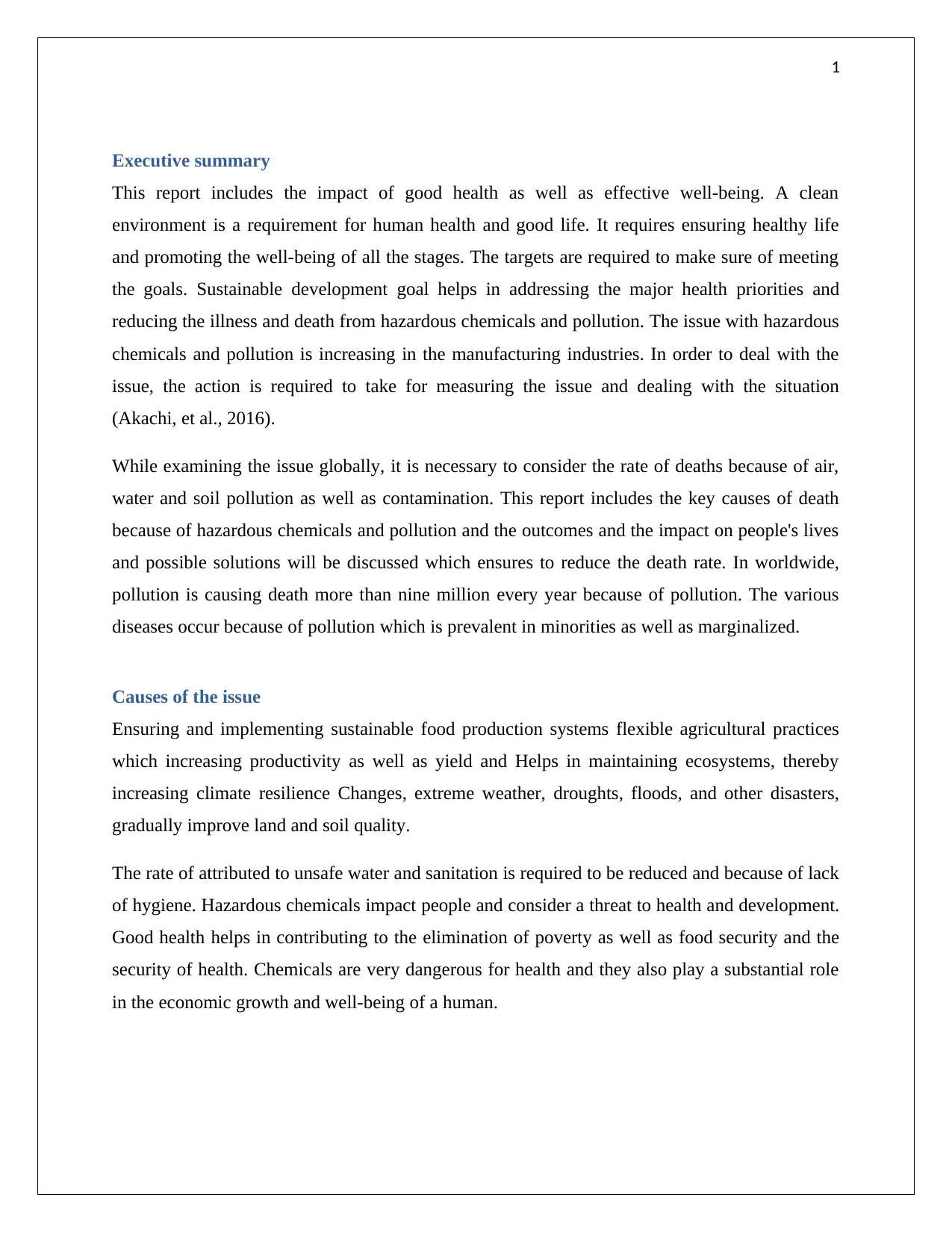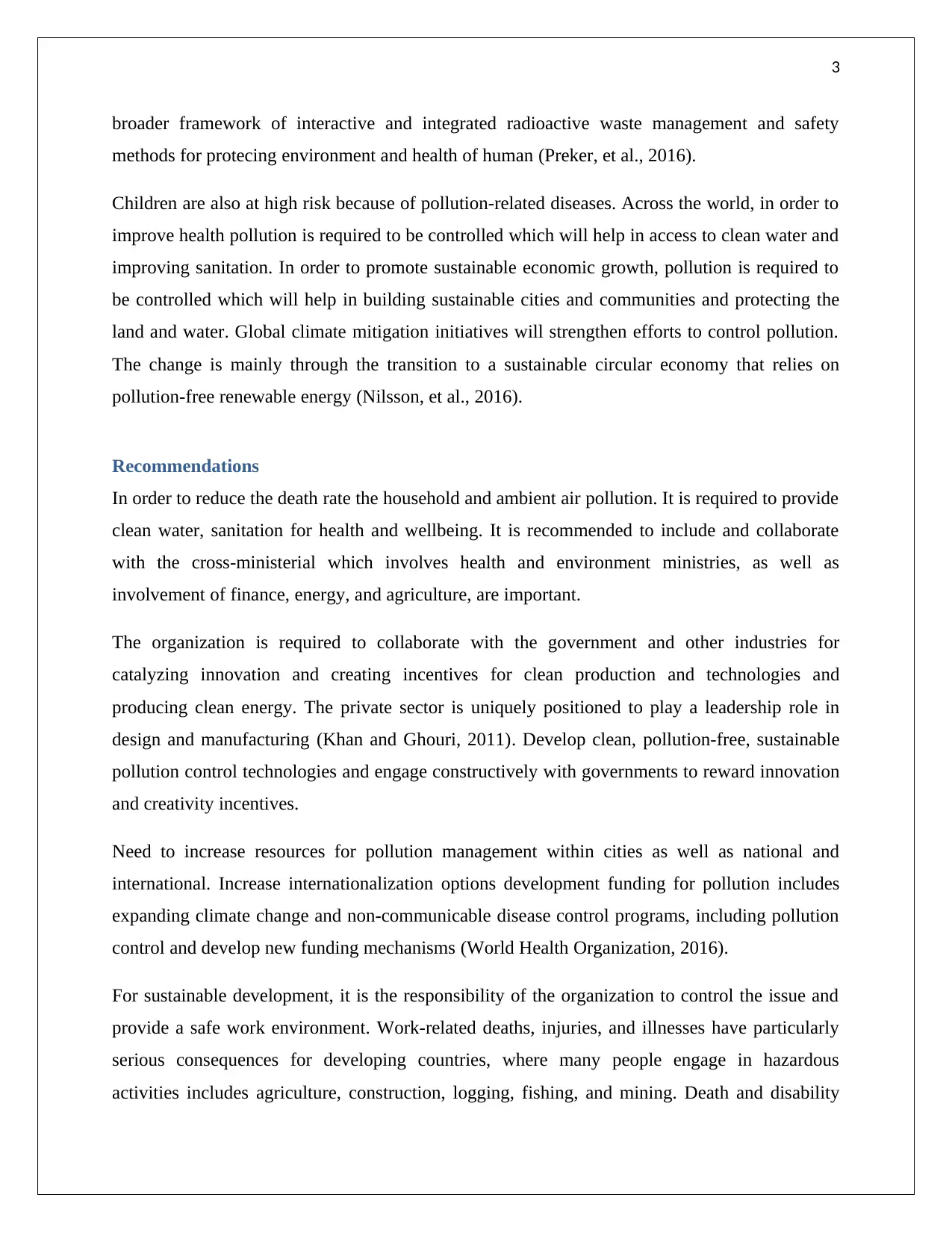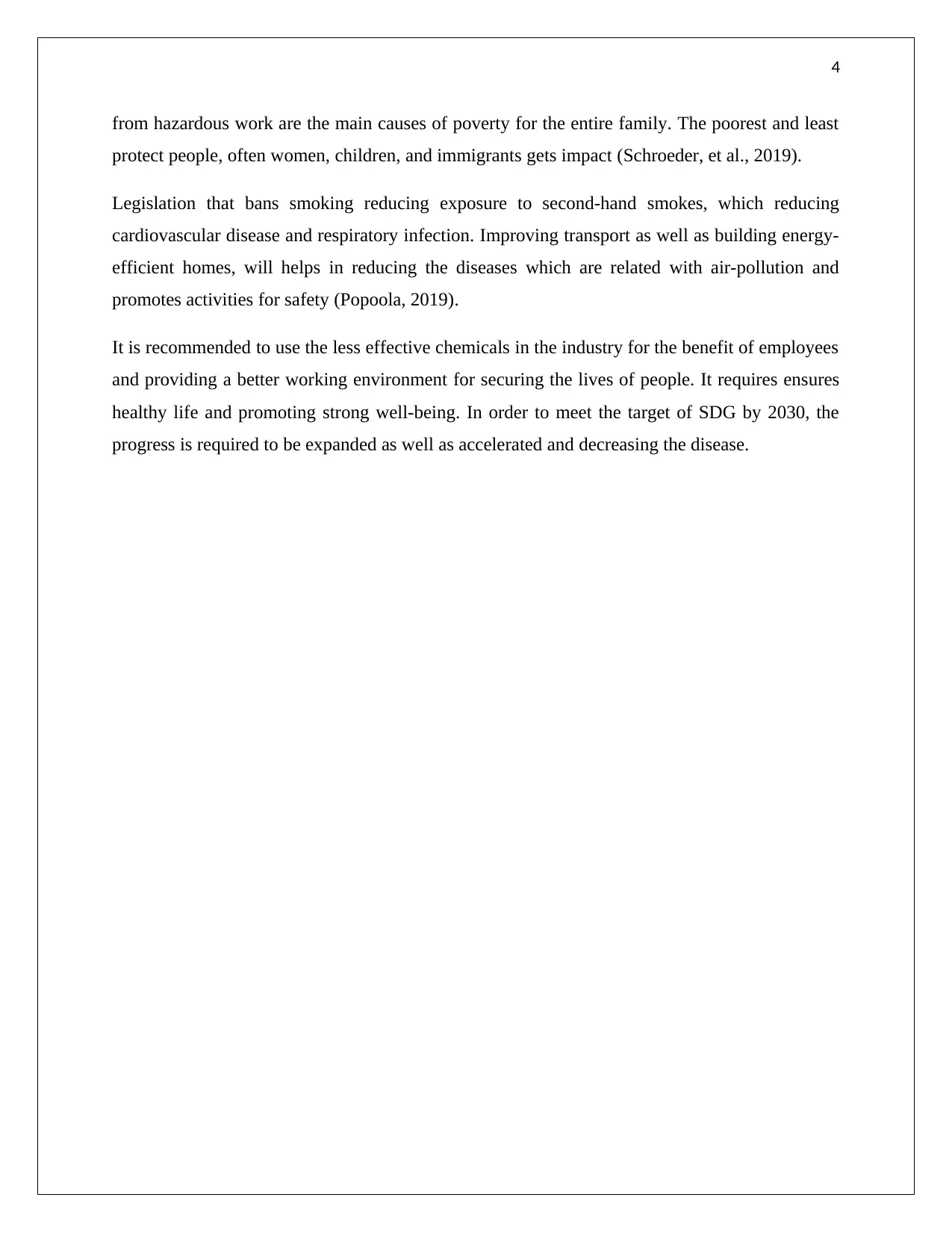Macquarie University: WACO1003 Health and Well-being Report Analysis
VerifiedAdded on 2022/08/16
|6
|1563
|9
Report
AI Summary
This report delves into the critical aspects of health and well-being, emphasizing the detrimental effects of pollution and hazardous chemicals. It underscores the importance of a clean environment for human health and a good life, aligning with sustainable development goals. The report explores the causes of pollution-related deaths, the outcomes on people's lives, and proposes solutions such as clean technologies, improved sanitation, and international collaboration. It highlights the impact of hazardous chemicals in various environments, leading to diseases and the need for risk assessment and management. The report emphasizes the need for governmental and organizational actions, including pollution control, clean production, and investment in new technologies. Recommendations include providing clean water, sanitation, and engaging with various sectors to catalyze innovation and create incentives for clean energy and technologies, aiming to reduce death rates and promote a sustainable and healthy environment.

0
Health and well-being
Health and well-being
Paraphrase This Document
Need a fresh take? Get an instant paraphrase of this document with our AI Paraphraser

1
Executive summary
This report includes the impact of good health as well as effective well-being. A clean
environment is a requirement for human health and good life. It requires ensuring healthy life
and promoting the well-being of all the stages. The targets are required to make sure of meeting
the goals. Sustainable development goal helps in addressing the major health priorities and
reducing the illness and death from hazardous chemicals and pollution. The issue with hazardous
chemicals and pollution is increasing in the manufacturing industries. In order to deal with the
issue, the action is required to take for measuring the issue and dealing with the situation
(Akachi, et al., 2016).
While examining the issue globally, it is necessary to consider the rate of deaths because of air,
water and soil pollution as well as contamination. This report includes the key causes of death
because of hazardous chemicals and pollution and the outcomes and the impact on people's lives
and possible solutions will be discussed which ensures to reduce the death rate. In worldwide,
pollution is causing death more than nine million every year because of pollution. The various
diseases occur because of pollution which is prevalent in minorities as well as marginalized.
Causes of the issue
Ensuring and implementing sustainable food production systems flexible agricultural practices
which increasing productivity as well as yield and Helps in maintaining ecosystems, thereby
increasing climate resilience Changes, extreme weather, droughts, floods, and other disasters,
gradually improve land and soil quality.
The rate of attributed to unsafe water and sanitation is required to be reduced and because of lack
of hygiene. Hazardous chemicals impact people and consider a threat to health and development.
Good health helps in contributing to the elimination of poverty as well as food security and the
security of health. Chemicals are very dangerous for health and they also play a substantial role
in the economic growth and well-being of a human.
Executive summary
This report includes the impact of good health as well as effective well-being. A clean
environment is a requirement for human health and good life. It requires ensuring healthy life
and promoting the well-being of all the stages. The targets are required to make sure of meeting
the goals. Sustainable development goal helps in addressing the major health priorities and
reducing the illness and death from hazardous chemicals and pollution. The issue with hazardous
chemicals and pollution is increasing in the manufacturing industries. In order to deal with the
issue, the action is required to take for measuring the issue and dealing with the situation
(Akachi, et al., 2016).
While examining the issue globally, it is necessary to consider the rate of deaths because of air,
water and soil pollution as well as contamination. This report includes the key causes of death
because of hazardous chemicals and pollution and the outcomes and the impact on people's lives
and possible solutions will be discussed which ensures to reduce the death rate. In worldwide,
pollution is causing death more than nine million every year because of pollution. The various
diseases occur because of pollution which is prevalent in minorities as well as marginalized.
Causes of the issue
Ensuring and implementing sustainable food production systems flexible agricultural practices
which increasing productivity as well as yield and Helps in maintaining ecosystems, thereby
increasing climate resilience Changes, extreme weather, droughts, floods, and other disasters,
gradually improve land and soil quality.
The rate of attributed to unsafe water and sanitation is required to be reduced and because of lack
of hygiene. Hazardous chemicals impact people and consider a threat to health and development.
Good health helps in contributing to the elimination of poverty as well as food security and the
security of health. Chemicals are very dangerous for health and they also play a substantial role
in the economic growth and well-being of a human.

2
Hazardous chemicals in the air, water, food, and occupations environments have potential which
causes a variety of diseases like cancer; fetal malformed respiratory diseases, endocrine diseases
(Akachi, et al., 2016).
Toxic discharge of untreated industrial wastewater into the water bodies used for crop irrigation
to contaminate soil, make groundwater and surface water sources are unsafe for agricultural and
domestic use. Direct soil pollution impact of agricultural production by destroying soil fertility
and absorb chemicals and heavy metals into crops and then consume them people and livestock.
The problem is increasing because of the lack of sufficient information to assess the risk as well
as risk for assessing the chemicals. Total chemical pollution is seriously endangering human
health, genetic structure, reproductive achievements, and the environment. It is still continuing in
some of the most important industrial fields in the world. Recovery will require substantial
investment and the development of new technologies (Chapman, 2016).
The report cited proved approaches to improve the environment and to prevent disease. For
example, use technologies for cleaning and fuels for home cooking, heating and lighting will
reduce acute respiratory infections, chronic respiratory diseases, cardiovascular diseases, and
burns. Increasing access to safe water and proper sanitation and promoting handwashing will
further reduce diarrhoeal diseases.
Issue outcomes
In order to limit the chemicals for reducing the hazardous and death of people working in
manufacturing industries requires precautions. The following research includes the key outcomes
and benefits for reducing the use of chemicals.
As a consequence of considering the issue, World Summit on Sustainable Development
emphasized the significance of effective liability measures for the international maritime
transport and other transboundary movements of radioactive material, radioactive waste and
spent nuclear fuel, and encouraged Governments to review and improves measures related to the
safe disposal, transportation and disposal of waste and internationally recognized regulations.
Ensure the safe management, transport, storage and disposal of radioactive waste within the
Hazardous chemicals in the air, water, food, and occupations environments have potential which
causes a variety of diseases like cancer; fetal malformed respiratory diseases, endocrine diseases
(Akachi, et al., 2016).
Toxic discharge of untreated industrial wastewater into the water bodies used for crop irrigation
to contaminate soil, make groundwater and surface water sources are unsafe for agricultural and
domestic use. Direct soil pollution impact of agricultural production by destroying soil fertility
and absorb chemicals and heavy metals into crops and then consume them people and livestock.
The problem is increasing because of the lack of sufficient information to assess the risk as well
as risk for assessing the chemicals. Total chemical pollution is seriously endangering human
health, genetic structure, reproductive achievements, and the environment. It is still continuing in
some of the most important industrial fields in the world. Recovery will require substantial
investment and the development of new technologies (Chapman, 2016).
The report cited proved approaches to improve the environment and to prevent disease. For
example, use technologies for cleaning and fuels for home cooking, heating and lighting will
reduce acute respiratory infections, chronic respiratory diseases, cardiovascular diseases, and
burns. Increasing access to safe water and proper sanitation and promoting handwashing will
further reduce diarrhoeal diseases.
Issue outcomes
In order to limit the chemicals for reducing the hazardous and death of people working in
manufacturing industries requires precautions. The following research includes the key outcomes
and benefits for reducing the use of chemicals.
As a consequence of considering the issue, World Summit on Sustainable Development
emphasized the significance of effective liability measures for the international maritime
transport and other transboundary movements of radioactive material, radioactive waste and
spent nuclear fuel, and encouraged Governments to review and improves measures related to the
safe disposal, transportation and disposal of waste and internationally recognized regulations.
Ensure the safe management, transport, storage and disposal of radioactive waste within the
⊘ This is a preview!⊘
Do you want full access?
Subscribe today to unlock all pages.

Trusted by 1+ million students worldwide

3
broader framework of interactive and integrated radioactive waste management and safety
methods for protecing environment and health of human (Preker, et al., 2016).
Children are also at high risk because of pollution-related diseases. Across the world, in order to
improve health pollution is required to be controlled which will help in access to clean water and
improving sanitation. In order to promote sustainable economic growth, pollution is required to
be controlled which will help in building sustainable cities and communities and protecting the
land and water. Global climate mitigation initiatives will strengthen efforts to control pollution.
The change is mainly through the transition to a sustainable circular economy that relies on
pollution-free renewable energy (Nilsson, et al., 2016).
Recommendations
In order to reduce the death rate the household and ambient air pollution. It is required to provide
clean water, sanitation for health and wellbeing. It is recommended to include and collaborate
with the cross-ministerial which involves health and environment ministries, as well as
involvement of finance, energy, and agriculture, are important.
The organization is required to collaborate with the government and other industries for
catalyzing innovation and creating incentives for clean production and technologies and
producing clean energy. The private sector is uniquely positioned to play a leadership role in
design and manufacturing (Khan and Ghouri, 2011). Develop clean, pollution-free, sustainable
pollution control technologies and engage constructively with governments to reward innovation
and creativity incentives.
Need to increase resources for pollution management within cities as well as national and
international. Increase internationalization options development funding for pollution includes
expanding climate change and non-communicable disease control programs, including pollution
control and develop new funding mechanisms (World Health Organization, 2016).
For sustainable development, it is the responsibility of the organization to control the issue and
provide a safe work environment. Work-related deaths, injuries, and illnesses have particularly
serious consequences for developing countries, where many people engage in hazardous
activities includes agriculture, construction, logging, fishing, and mining. Death and disability
broader framework of interactive and integrated radioactive waste management and safety
methods for protecing environment and health of human (Preker, et al., 2016).
Children are also at high risk because of pollution-related diseases. Across the world, in order to
improve health pollution is required to be controlled which will help in access to clean water and
improving sanitation. In order to promote sustainable economic growth, pollution is required to
be controlled which will help in building sustainable cities and communities and protecting the
land and water. Global climate mitigation initiatives will strengthen efforts to control pollution.
The change is mainly through the transition to a sustainable circular economy that relies on
pollution-free renewable energy (Nilsson, et al., 2016).
Recommendations
In order to reduce the death rate the household and ambient air pollution. It is required to provide
clean water, sanitation for health and wellbeing. It is recommended to include and collaborate
with the cross-ministerial which involves health and environment ministries, as well as
involvement of finance, energy, and agriculture, are important.
The organization is required to collaborate with the government and other industries for
catalyzing innovation and creating incentives for clean production and technologies and
producing clean energy. The private sector is uniquely positioned to play a leadership role in
design and manufacturing (Khan and Ghouri, 2011). Develop clean, pollution-free, sustainable
pollution control technologies and engage constructively with governments to reward innovation
and creativity incentives.
Need to increase resources for pollution management within cities as well as national and
international. Increase internationalization options development funding for pollution includes
expanding climate change and non-communicable disease control programs, including pollution
control and develop new funding mechanisms (World Health Organization, 2016).
For sustainable development, it is the responsibility of the organization to control the issue and
provide a safe work environment. Work-related deaths, injuries, and illnesses have particularly
serious consequences for developing countries, where many people engage in hazardous
activities includes agriculture, construction, logging, fishing, and mining. Death and disability
Paraphrase This Document
Need a fresh take? Get an instant paraphrase of this document with our AI Paraphraser

4
from hazardous work are the main causes of poverty for the entire family. The poorest and least
protect people, often women, children, and immigrants gets impact (Schroeder, et al., 2019).
Legislation that bans smoking reducing exposure to second-hand smokes, which reducing
cardiovascular disease and respiratory infection. Improving transport as well as building energy-
efficient homes, will helps in reducing the diseases which are related with air-pollution and
promotes activities for safety (Popoola, 2019).
It is recommended to use the less effective chemicals in the industry for the benefit of employees
and providing a better working environment for securing the lives of people. It requires ensures
healthy life and promoting strong well-being. In order to meet the target of SDG by 2030, the
progress is required to be expanded as well as accelerated and decreasing the disease.
from hazardous work are the main causes of poverty for the entire family. The poorest and least
protect people, often women, children, and immigrants gets impact (Schroeder, et al., 2019).
Legislation that bans smoking reducing exposure to second-hand smokes, which reducing
cardiovascular disease and respiratory infection. Improving transport as well as building energy-
efficient homes, will helps in reducing the diseases which are related with air-pollution and
promotes activities for safety (Popoola, 2019).
It is recommended to use the less effective chemicals in the industry for the benefit of employees
and providing a better working environment for securing the lives of people. It requires ensures
healthy life and promoting strong well-being. In order to meet the target of SDG by 2030, the
progress is required to be expanded as well as accelerated and decreasing the disease.

5
Reference
Akachi, Y., Tarp, F., Kelley, E., Addison, T. and Kruk, M.E., 2016. Measuring quality-of-care in
the context of sustainable development goal 3: a call for papers. Bulletin of the World Health
Organization, 94(3), p.160.
Chapman, A.R., 2016. The problems with the proposed indicators for monitoring universal
health coverage in the Sustainable Development Goals. Health and Human Rights Journal.
Khan, M.A. and Ghouri, A.M., 2011. Environmental pollution: Its effects on life and its
remedies. Researcher World: Journal of Arts, Science & Commerce, 2(2), pp.276-285.
Nilsson, M., Griggs, D. and Visbeck, M., 2016. Policy: map the interactions between Sustainable
Development Goals. Nature, 534(7607), pp.320-322.
Popoola, B.O., 2019. Involving libraries in improving health literacy to achieve Sustainable
Development Goal‐3 in developing economies: a literature review. Health Information &
Libraries Journal, 36(2), pp.111-120.
Preker, A.S., Adeyi, O.O., Lapetra, M.G., Simon, D.C. and Keuffel, E., 2016. Health care
expenditures associated with pollution: exploratory methods and findings. Annals of global
health, 82(5), pp.711-721.
Schroeder, P., Anggraeni, K. and Weber, U., 2019. The relevance of circular economy practices
to the sustainable development goals. Journal of Industrial Ecology, 23(1), pp.77-95.
World Health Organization, 2016. Sustainable development goals (SDGs): Goal 3. Target 3.9:
By 2030, substantially reduce the number of deaths and illnesses from hazardous chemicals and
air, water and soil pollution and contamination.
Reference
Akachi, Y., Tarp, F., Kelley, E., Addison, T. and Kruk, M.E., 2016. Measuring quality-of-care in
the context of sustainable development goal 3: a call for papers. Bulletin of the World Health
Organization, 94(3), p.160.
Chapman, A.R., 2016. The problems with the proposed indicators for monitoring universal
health coverage in the Sustainable Development Goals. Health and Human Rights Journal.
Khan, M.A. and Ghouri, A.M., 2011. Environmental pollution: Its effects on life and its
remedies. Researcher World: Journal of Arts, Science & Commerce, 2(2), pp.276-285.
Nilsson, M., Griggs, D. and Visbeck, M., 2016. Policy: map the interactions between Sustainable
Development Goals. Nature, 534(7607), pp.320-322.
Popoola, B.O., 2019. Involving libraries in improving health literacy to achieve Sustainable
Development Goal‐3 in developing economies: a literature review. Health Information &
Libraries Journal, 36(2), pp.111-120.
Preker, A.S., Adeyi, O.O., Lapetra, M.G., Simon, D.C. and Keuffel, E., 2016. Health care
expenditures associated with pollution: exploratory methods and findings. Annals of global
health, 82(5), pp.711-721.
Schroeder, P., Anggraeni, K. and Weber, U., 2019. The relevance of circular economy practices
to the sustainable development goals. Journal of Industrial Ecology, 23(1), pp.77-95.
World Health Organization, 2016. Sustainable development goals (SDGs): Goal 3. Target 3.9:
By 2030, substantially reduce the number of deaths and illnesses from hazardous chemicals and
air, water and soil pollution and contamination.
⊘ This is a preview!⊘
Do you want full access?
Subscribe today to unlock all pages.

Trusted by 1+ million students worldwide
1 out of 6
Related Documents
Your All-in-One AI-Powered Toolkit for Academic Success.
+13062052269
info@desklib.com
Available 24*7 on WhatsApp / Email
![[object Object]](/_next/static/media/star-bottom.7253800d.svg)
Unlock your academic potential
Copyright © 2020–2025 A2Z Services. All Rights Reserved. Developed and managed by ZUCOL.





